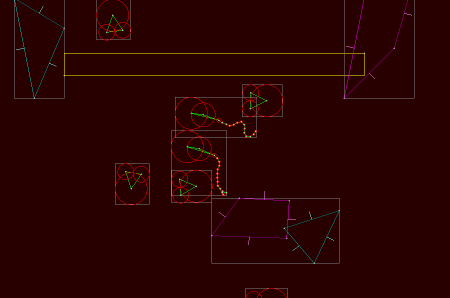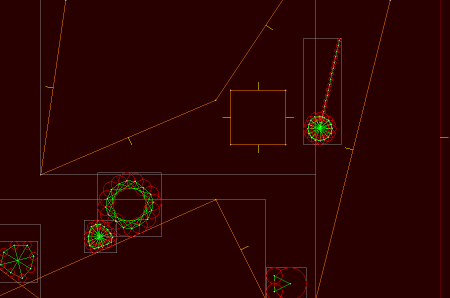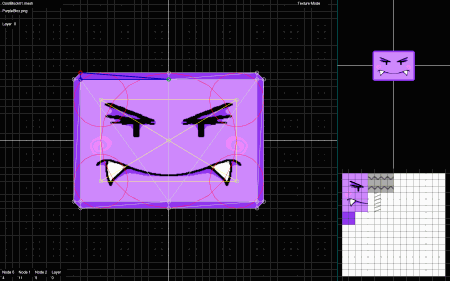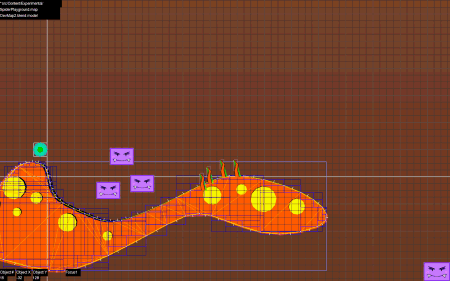This next engines name and story is a little complicated.
Game development became a constant burn out for me. Since finishing Secret Agent Barbie (Gameboy Advance) and Polly Pocket (Gameboy Advance), it became clear to me the only thing keeping me going was my fascination with new platforms. Certainly not the subject matter.
After we finished Polly Pocket, I asked for a month off to deal with my burn out. However, we quickly picked up a new game, Barbie: Gotta Have Games (Playstation). The game was incredibly late in the Playstation lifetime, but Barbie’s a hard brand to make fail. This was my last chance to do a Playstation 1 game, with the PS2 nearly 3 years old at the time. I had to take it.
After that was finally done, I took my month off. I wouldn’t say I was recovered, but I was in heck of a lot better shape than I was before I left. That lead to Brown Box, leaving DICE, joining my friends company to “play” management, and eventually to Destructure.
As Atomic Betty was going to be my last project at Big Blue, Destructure was retired as the Atomic Betty engine. Whenever I start an engine project, I always intend on making something reusable. But as usual, I end up with too many things I want to do differently the next time.
So a burned out programmer, all of his last 5 notable projects girl games, anxiously anticipating his chance to finally do the games he wants to. What sort of iconic name has he brewed for his engine?
He calls it Freedom.
Now, I don’t want to give the wrong impression. Big Blue was and still is the best company I’ve worked for, and I’d gladly work with them again. The engine name is about philosophical freedom. I like to joke with friends about my girl game curse. In actuality, I’m just not happy working in the traditional business model of developing licensed games. Of course it’s possible I’ll do a project again to replenish my reserves, but I can still go a while longer.
Outside of my early retirement, the Freedom engine was motivated by the console downloadable game revolution. It didn’t exist yet, but we all knew it was coming (fingers crossed). I was officially “retired” in August 2005, and that’s when my focus became Freedom.
With the 360 only a few months away, I was going to be ready!!
…
Oh… that’s right! It seems I’d forgotten about the burn out.
Truthfully, I don’t think I was ready for anything until at least a year later. That didn’t stop me from chaotically developing whatever seemed cool at the time.
Going back again, Destructure was inspired by the potential of downloadable games of the time. This was mid 2004, where this was Casual games. Back then, I was an Indiegamer regular. I watched and discussed business theory with many who have gone on to become major players in casual games. I’d even gotten myself involved in GameTunnel, to do extra research. At Big Blue, we’d regularly geekishly discuss the casual and mobile games market, as we worked our asses off to recreate the glory days of DICE’s “Team Gameboy”. We came close enough, girl game and all. ![]()
But with projects like Gastronaut’s Fuzzee Fever on the original XBLA, and The Behemoth’s Alien Hominid, the juices of inspiration and potential were not only flowing, but boiling and bubbling. Where Destructure started with the goal of breaking in to PC casual games, Freedom was nextgen.
Freedom was designed to be an HD ready 2D game engine. As a result, one of the earliest purchases I made was one of those lovely 24″ Dell’s. Slightly higher resolution than a 1080p HDTV, and *much* cheaper. As before, the PuffBOMB remake was on the agenda, but structure doesn’t come easy to a burn out.

Early Freedom experiments
So the Freedom engine was built, and it became a testbed for physics ideas. Eventually I’d start toying with Gish like squishy blobs, and ropes. This lead to The Spider, a double rope platformer experiment, again, spearheaded by the sound mind of a freshly “retired” burned out coder.

Freedom experiments that evolved in to The Spider
I’ve already talked about The Spider a bunch already (with videos) in my previous attempts to get up to date. Check these out if you want to know more.
Part 1, Part 2, Part 3, Part 4
Part 5, Part 6, Part 7, Part “+1″
Videos: New Part 1, New Part 2
During The Spider was also when I recruited my brother to help out. This was near the end of 2005. His main task was editor programming while I built the engine. We’d share the content building duties.

Freedom’s Object Editor

Freedom’s Map Editor
He’d previously worked on some contract mobile games, as well as helping out on my earlier efforts. Of note, he did most of the map and world building on Murmur’s Dungeon (the 6-1997 game above), and helped a bunch with the character design on Islandgates (the 10-1997 game, lots of content we never got around to using).
As expected, bringing on somebody new (especially someone as familiar and opinionated as a sibling) encouraged a bit of an identity crisis for The Spider project. Despite, as I’ve suggested before, the game wasn’t well developed either. Adding him probably helped more than hurt.
During development of The Spider, it became clear that the goals of the project weren’t clear. More ambitious than anything. With tools, a working engine in hand, and some outside “encouragement”, we started discussing games of smaller scope we could pull off.
The Spider was followed by the destructible scenery project, Ballistic Force.